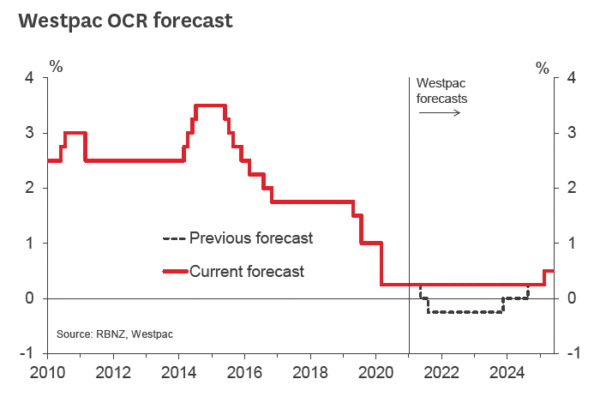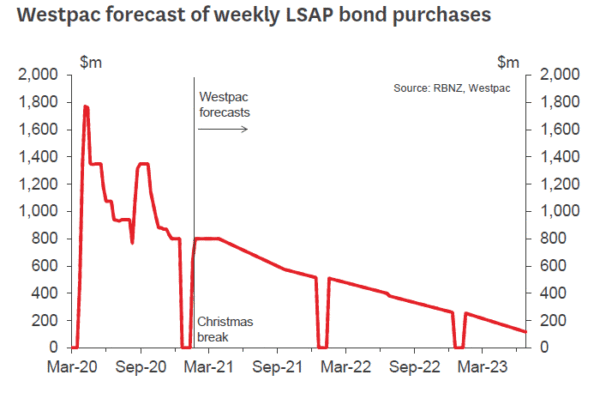- We now expect the OCR to remain on hold for the foreseeable future (previously we expected two cuts this year).
- The OCR needs to remain very low due to low inflation and high unemployment.
- But recent strong GDP and housing data suggests that the OCR is now low enough.
- We expect annual house price inflation will peak at 20% later this year, which is not an environment conducive to further OCR cuts.
We now expect that the OCR will remain on hold at 0.25% for the foreseeable future. Previously, we were forecasting two cuts of 25bps in May and August this year, which would have taken the OCR to -0.25%.
The situation is still very challenging for the Reserve Bank, and there is still a great need for monetary stimulus. Covid-19 headwinds continue to be a significant drag on parts of the economy. And against that backdrop, inflation has fallen to low levels. In fact, we expect this Friday’s December quarter CPI update will show that inflation has now fallen to just 1% – right at the bottom of the RBNZ’s target band. At the same time, joblessness has been on the rise with the unemployment rate estimated to have increased to 6% at end of last year.
To complicate matters, the RBNZ faces two challenges in providing the monetary stimulus required to rectify this undesired weakness in inflation and employment. The exchange rate has risen in recent months and could rise further from here. And the RBNZ’s Large Scale Asset Purchase programme (also known as quantitative easing) is going to run out of fuel. The Government has scaled back its bond issuance plans, meaning there are fewer bonds available for the RBNZ to buy. As the RBNZ slows the rate of bond purchases, the result will be higher long-term interest rates.
However, developments over the past month or so have called into question the degree of monetary stimulus that will be required. The OCR needs to stay low, but we no longer expect that it will need to go lower.
- The economy has weathered the Covid storm better than anticipated, and GDP has already recovered to its pre-Covid level. True, very recent indicators suggest that GDP growth in the December 2020 and March 2021 quarters will be very low or even negative, mainly because of the lack of international tourists over the normally-busy summer months. But even if GDP does decline over summer, the economy will still be operating at a far healthier level than previously anticipated.
- The housing market has outstripped even our very bullish expectations. We now predict that annual house price inflation will peak at 20% later this year (previously 16%). And looking at 2021 as a whole, we are now forecasting that house prices will rise 15%, on top of the 12% increase over 2020. The reason for this surge in prices is the sudden drop in mortgage rates engineered by the RBNZ.
- Global supply and distribution of goods has been disrupted by Covid-19. Supply shortages could temporarily boost inflation in New Zealand. On a related note, global oil prices have risen in recent months, along with prices for other key global commodities – again, this could help to boost inflation in New Zealand.
The surge in house prices is particularly important. It is now abundantly clear that the RBNZ’s OCR cuts have had a stimulatory effect on house prices. In time, the buoyant housing market will stimulate consumer spending and inflation. The impact of monetary policy on house prices has proven far more potent than the RBNZ anticipated. Now is a time for the RBNZ to sit back and observe how the stimulus it has provided translates from house prices to the economy and then to inflation, rather than to cut further. It just does not seem likely that the RBNZ would cut the OCR amid 20% house price inflation.
As always, there are two-sided risks around our new forecast. Should inflation and employment prove stronger or weaker than we currently anticipate, the OCR outlook would be adjusted up or down accordingly. In particular, we continue to regard a negative OCR as a perfectly viable policy option for the RBNZ. If the data unexpectedly turns in a more negative direction, the RBNZ would not hesitate the lower the OCR below zero.
We continue to expect that the RBNZ will gradually taper the pace of Government bond purchases over the course of the year, from the recent average of $800m per week down to around $500m by the end of the year.
Westpac forecast of weekly LSAP bond purchases
To date, we have been forecasting that the NZD/AUD exchange rate would fall this year, and that the NZD would rise only a little against the USD, in an environment where most currencies are expected to rise against the USD. However, given that we are no longer expecting OCR cuts, we now see more scope for the NZD to rise. We will review our exchange rate forecasts over the coming couple of days and release new exchange rate forecasts in our next Weekly Commentary.














